
The American Revolution.
Isaac Newton discovering gravity.
The Continental Congress adopting the Declaration of Independence.
What do all of these events have in common?
They happened after Friedrich Jacob Merck took control of the Engel-Apotheke, which would eventually become one of the world’s biggest pharmaceutical companies.
If that name doesn’t ring a bell, maybe its current one does: Merck.
Yes, that Merck—the same one that reported $48.7b in sales last year.
In the more than 4 centuries since Merck’s inception, it’s seen a thing or two—including the evolution of pharmaceutical advertising.
Unfortunately, we can’t travel back in time and witness this evolution, but we can see how pharma companies spent their ad dollars last year.
Here’s what you need to know about how pharma companies—new and old—spent their ad dollars in 2021.
Pharma Advertising in 2021: Spending Stalls
After spending increased by 32% YoY in 2018, it’s come to a halt.
In 2019, pharma ad spending increased by 2% YoY, driven primarily by a 6% boost in TV buys.
In 2020, spending was flat, despite a siloed boost to digital, which increased by 74% YoY as consumer buying habits changed during the pandemic.
In 2021, spending went up by 1%.
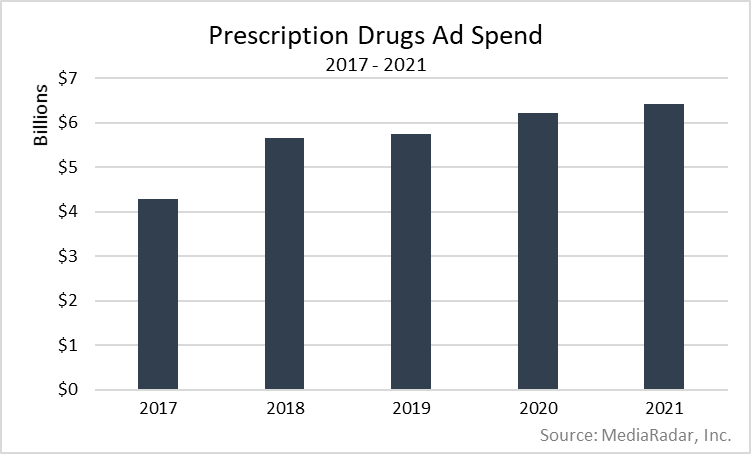
While declining or stabilizing ad spending typically indicates that trouble’s brewing—struggling companies usually don’t have the fund to spend on advertising—in this case, it points to the immunity of pharma advertisers, especially when considering the pre-pandemic increase in spending.
In 2021, the top-spending categories accounted for 43% of all spending.
Diabetes is number one, accounting for 12% of total spending, followed by Psoriasis (10%), Arthritis (9%), HIV/AIDS (6%) and Breast Cancer (6%).
TV was the media of choice for advertisers in these categories, with Diabetes holding the top spot.
Digital spending lagged considerably, although the HIV/AIDS category increased its digital spending to 28% (others allocated between 5% and 16% to digital).

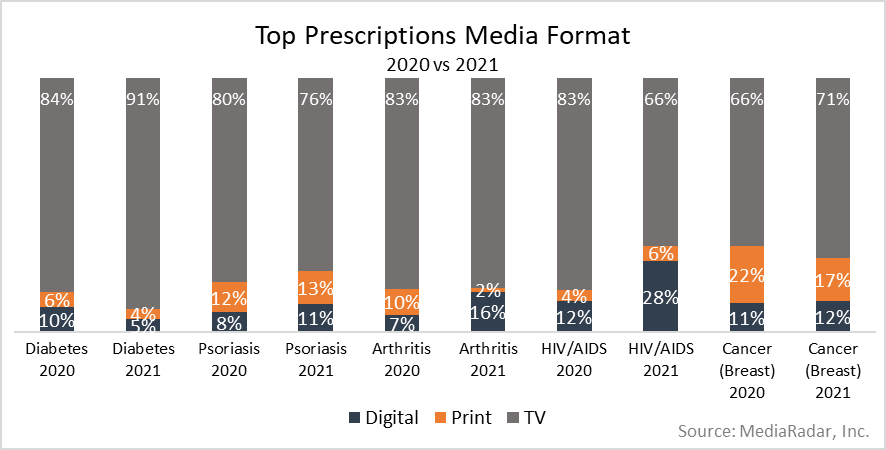
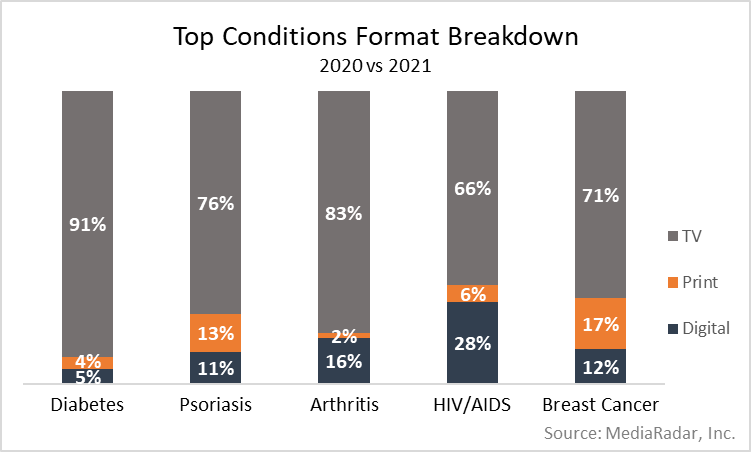
A Closer Look at Pharma Ad Spending in 2021
Despite relatively little to write home about in terms of overall growth in spending, there’s plenty worth noting if we look a little closer.
There are more advertisers than ever
It would make sense that the sluggish spending would also come with a similar trend in the number of pharma companies buying ads.
But that’s not what happened.
In 2021, the number of pharma companies buying ads for different prescription drugs increased by 17% and 15%, respectively.
A big part of that had to do with the fact that 48 new companies jumped on the advertising bandwagon (more on them in a bit).
The increase in the number of advertisers and ads is easy to understand.
The FDA approved 50 new prescription drugs last year.
But why didn’t spending follow suit?
It likely has to do with two factors:
Even though the pandemic didn’t lead to a mass exodus, many likely adopted a more reserved approach to buying pharmaceutical drugs.
The new entrants may also have been ramping up spending as they determined if their drugs took hold in the market, similar to how a startup dips their toes gradually when entering a new industry.
New advertisers in 2021
In 2021, 50 new prescription drugs came on the market.
Yet, only five accounted for 75% of the nearly $135mm spent, including Cabenuva (HIV/AIDS), Verquvo (Cardiovascular), Xolair (CSU) (Allergy), Orgovyx (Cancer) and Ponvory (Multiple Sclerosis).
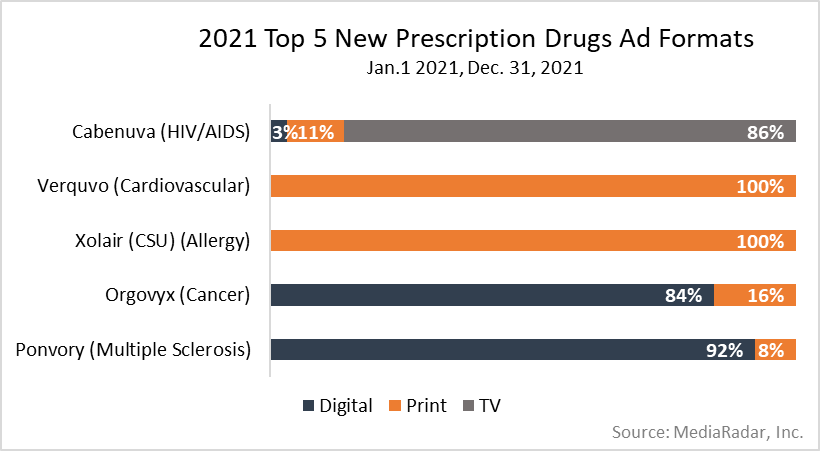
Of these new entrants, there were a couple of interesting insights.
For starters, Cabenuva was the only one that bought TV spots.
Those ads came in Q4 when it spent more than $1mm on spots on ABC, A&E, CBS, CNN, Fox, NBC and the USA, accounting for 75% of the total TV spend.
Meanwhile, Verquvo and Xolair invested in print ads.
More than a third of Verquvo’s print ads ended up in Better Homes, 14% in Southern Living, 12% in Woman’s Day and 9% in The New England Journal of Medicine.
The remaining (8% or less) went to Country Living, Popular Mechanics, TV Guide, Cardiology Today, The American Journal of Managed Care and The American Medical Association.
Xolair dedicated 30% of its print ad spend to Better Homes & Gardens, 27% to People, 9% to Women’s Health, 7% to Country Living and the remaining were 6% or less and included Us Weekly, Southern Living, Time, InStyle and Allure.
Finally, Orgovyx and Ponvory were the two that invested anything substantial in digital, allocating 84% and 92%, respectively, to digital ads.
The contrasting behaviors could have something to do with the companies manufacturing them (Sumitovant Biopharma and Johnson & Johnson) and their willingness to veer from the age-old approach of investing the bulk of ad dollars in print and other traditional formats.
Those commercials aren’t going away
It’s 2022 and most advertisers are shifting their ad dollars to digital.
Surprisingly (or unsurprisingly), pharma advertisers aren’t following the leader.
Instead, most of them are sticking to what they know best: TV spots.
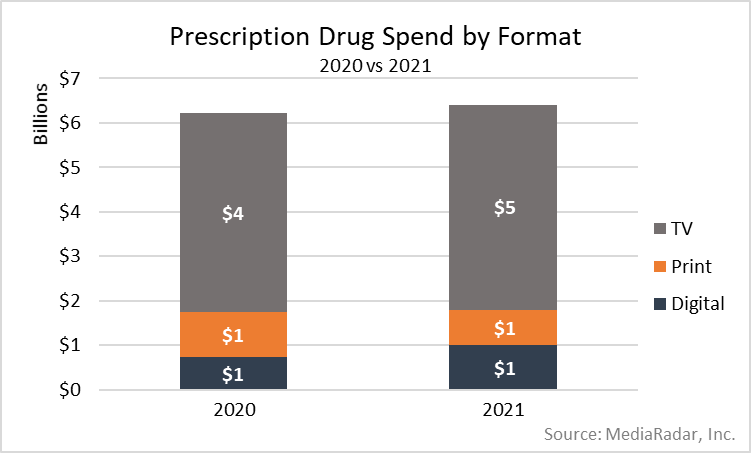
In 2021, TV spots accounted for more than 70% of total spending, increasing by 3% YoY from 2020.
That said, spending on print ads decreased by 22% YoY due mainly to a decrease in ad buys in People Magazine (down by 44%), Good Housekeeping (down by 25%) and Health (down by 21%).
The only print publications in the top 5 that saw an increase in spending were The New England Journal of Medicine (increased by 22%) and Better Homes & Gardens (increased by 4%).
The increase to The New England Journal of Medicine could signal a greater shift from industry advertisers to focus more on healthcare professionals (HCPs) instead of consumers.

Overall, the shift away from print is undoubtedly a result of the rise of telehealth during the pandemic as more opted for digital interactions with HCPs instead of face-to-face ones at the office—the same offices that littered the waiting rooms with magazines.
Digital ads are (slowly) becoming popular
While it’s impossible to ignore pharma advertisers’ adoration for TV, our data shows that many of them are finally experimenting with digital.
In 2021, digital ad buys increased by 60% YoY.
The number of prescription drugs advertising digitally increased by 19% YoY.
Looking specifically at how these advertisers spent on digital, we see that video increased by 32% YoY, with 99.5% going to YouTube.
Meanwhile, digital display saw a 59% increase in 2021, which took total spending beyond $378mm as Abbie and Sanofi SA increased their spending on display by 138% and 330%, respectively.

Still, digital accounts for just a fraction of spending and will take years to even remotely catch up.
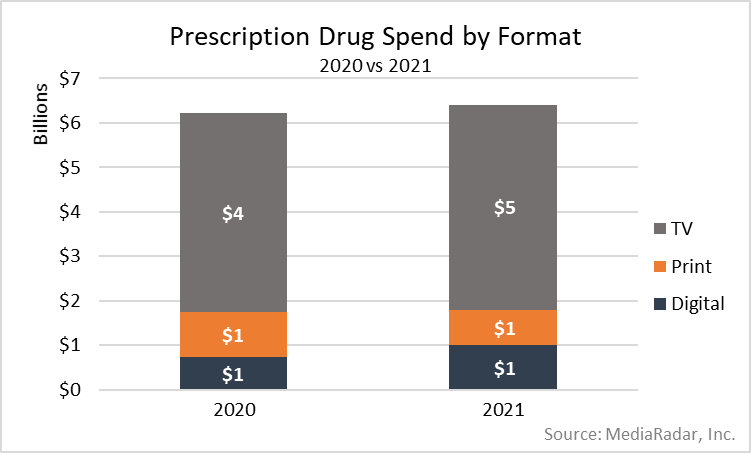
But, it is a start and should continue to rise as telehealth takes hold and more digital-first HCPs enter the workforce.
For now, expect most pharma advertisers to stay the course and stick to what they know.
At the same time, this presents an opportunity to more forward-facing advertisers to start building out a digital strategy that’ll unquestionably become the foundation of their approach for years to come.
To learn more about the data behind this article and what MediaRadar has to offer, visit https://mediaradar.com/.







Sign up to receive our stories in your inbox.
Data is changing the speed of business. Investors, Corporations, and Governments are buying new, differentiated data to gain visibility make better decisions. Don't fall behind. Let us help.













Sign up to receive our stories in your inbox.
Data is changing the speed of business. Investors, Corporations, and Governments are buying new, differentiated data to gain visibility make better decisions. Don't fall behind. Let us help.





